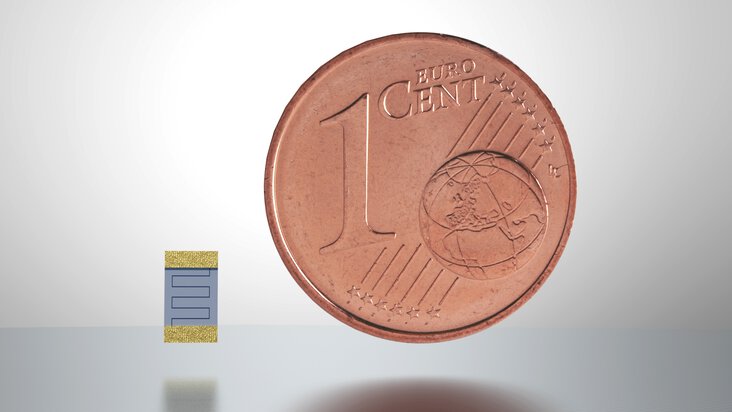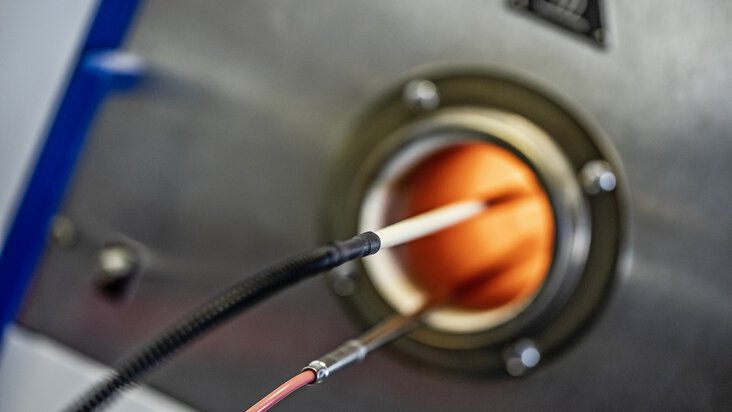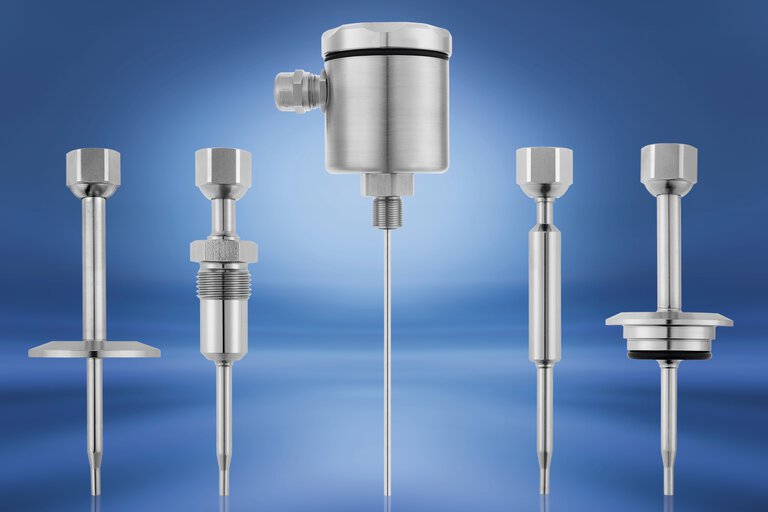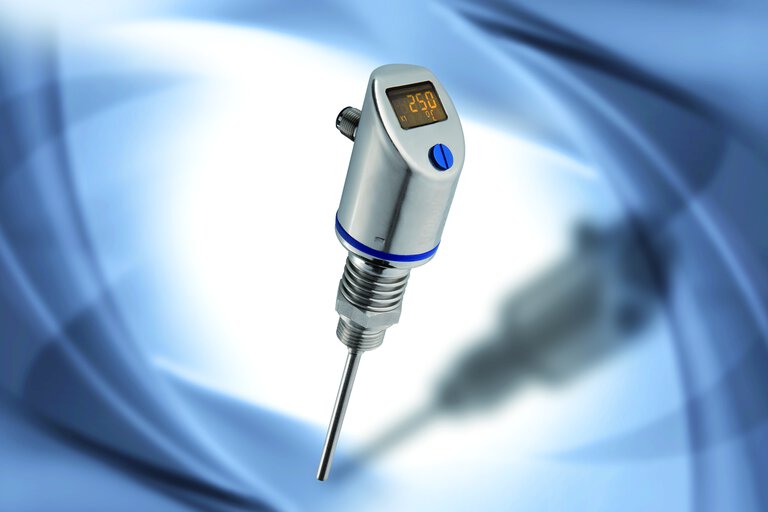
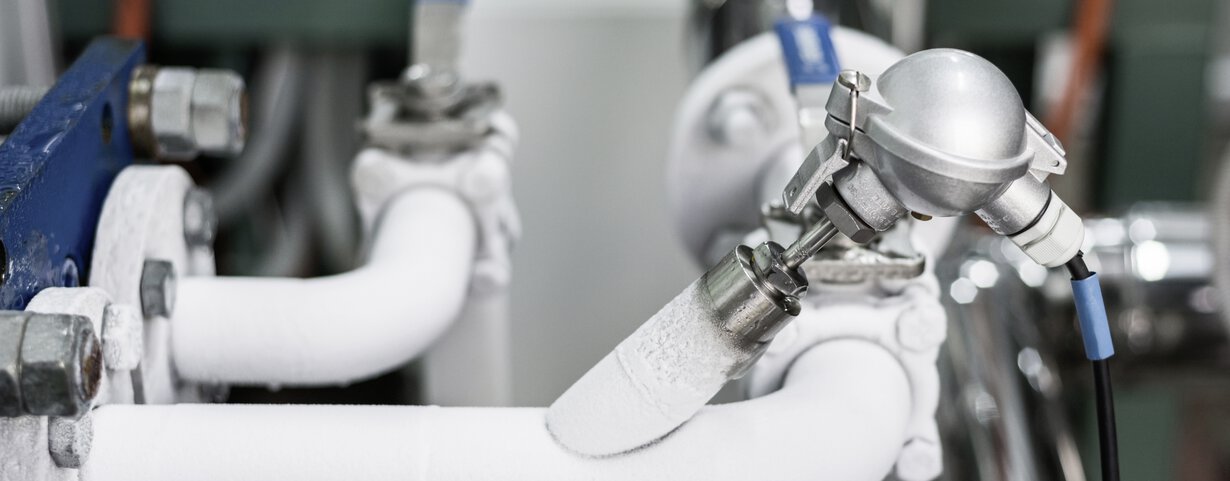
Temperature sensors for standard and highly specialised applications – resistance thermometers
The Pt100 temperature sensor is a common type of temperature sensor used in various types of measurement and control. The Pt100 sensor itself is the measuring element of the actual temperature sensor, which, in addition to the resistor, typically consists of connecting wires (drain and discharge cable) and external terminals for connecting electrical measuring instruments, as well as external components such as a shield, connection head or connection cable. In industry, the most commonly used is the Pt100 temperature sensor. Among all industrial temperature measurements, more than 70% are handled precisely by resistance temperature sensors built on the basis of the Pt100 sensor. Why? Mainly because of their wide measuring range, linearity of measurement characteristics, durability, accuracy and, last but not least, ease of connection.
How does a temperature sensor work?
Resistive temperature sensors operate based on the change in electrical resistance of a metal with temperature changes. By measuring these changes, it is possible to determine the temperature value.
Construction of the Pt100 temperature sensor
The Pt100 temperature sensor is a commonly used type of temperature sensor in various measurements and control applications. The platinum Pt100 sensor itself forms the measuring element of the temperature sensor, which, in addition to the resistor, typically includes connecting wires (lead-in and lead-out wires), external terminals for connecting electrical measuring instruments, and external components such as a sheath, connection head, or connecting cable. In industry, the Pt100 temperature sensor is most frequently used.
Resistive thermometer – advantages
Among all industrial temperature measurements, more than 70% are handled by Pt100 resistive temperature sensors. Why are these temperature sensors so widely used? Primarily due to their wide measurement range, linearity of the measurement characteristic, durability, accuracy, and ease of connection.
Pt100 sensors – characteristics
Although the term Pt100 specifically refers to the temperature sensor itself, this designation is often used synonymously with the resistive temperature sensor. Other commonly accepted terms for resistive temperature sensors include RTD sensor (from English: Resistance Temperature Device), resistive thermometer (industrial thermometer), resistive sensor, resistive temperature sensor, Pt100 thermometer, or resistance thermometer.
Pt100 temperature sensor – applications
The Pt100 temperature sensor is used for measuring the temperature of:
- Liquids
- Gases
- Machine parts
- Industrial installations
- Devices
Types of temperature sensors
We distinguish between the following types of temperature sensors:
- Integrated sensors
- Remote temperature sensors
- Semiconductor sensors
- Thermocouples (thermoelectric sensors)
- Thermoresistive sensors
JUMO Temperature Sensors
Are you looking for Pt100 resistance temperature sensors? Great! We have an exceptional offer for you, featuring a variety of resistive temperature sensors for different applications. JUMO Pt100 temperature sensors have been successfully used in almost all industrial sectors for many years. This is mainly due to their versatility and the wide range of highly specified versions of our RTD temperature sensors, as well as our reliable standard versions of resistance thermometers available in various configurations, such as screw-in sensors, plug-in sensors, and resistance sensors with connecting cables.
High-Precision Temperature Sensors
Do you need standalone platinum Pt100 temperature sensors? You’re in the right place! JUMO platinum Pt100 temperature sensors are manufactured using the latest thin-film technology. This guarantees excellent accuracy and long-term measurement stability of our sensors. What sets JUMO platinum temperature sensors apart is their wide temperature range (from -70°C to 600°C), the availability of many different models, and various resistance values.
Pt100 Temperature Sensor – Operating Principle
The operating principle of resistive sensors is based on the relationship between the temperature of a material and its resistivity – a change in temperature results in a change in resistivity. In Pt-type resistive sensors, where the sensor is made of platinum, an increase in temperature causes an increase in the sensor's resistivity.
Pt100 – Resistance
Therefore, if we can measure the change in resistance, we can also determine how much the temperature has increased. In the case of platinum, this is relatively straightforward because the relationship between resistance and temperature is linear. This minimizes the risk of unpredictable measurement anomalies.
The resistance value according to the European standard is: RPt100 = 100 + 0.385 055 x T. The positive temperature coefficient of Pt100 is 0.385 055 Ω/K. Alternatively: RPt100 = (100 + 0.390 802 x T - 0000 058 0195 x T^2).
Resistive Thermometer – Construction
Typically, platinum wire is wound around an insulated ceramic core. This prepared element is then inserted into a tube made of the same material. Other forms include a glass rod around which the wire is wound and then heated sufficiently to embed the wire in the glass.
Depending on the application, the measuring element is housed in a metal or glass casing. This casing must be durable enough to withstand the mechanical stresses that temperature sensors typically face in industrial applications. Other construction forms are also used, such as platinum deposited on a glass or ceramic plate or SMD versions. Resistive thermometers are constructed in various forms, often offering greater stability, accuracy, and repeatability than thermocouples (thermoelectric sensors).
How Does a Pt100 Sensor Work?
Temperature measurement with a resistive sensor is performed indirectly. It utilizes the resistance of the material from which the sensor is made. The ambient temperature is determined by measuring the resistance exhibited by the resistor. Platinum sensors are most commonly used due to their corrosion resistance and high melting temperature, although nickel or semiconductor sensors are also used.
Our Offer Includes:
- Temperature sensors with display
- Wireless temperature sensors
- Temperature and humidity sensors
- 0-10V temperature sensors
- Temperature sensors for hazardous areas (JUMO processTEMP)
- High-temperature sensors
Pt1000 Temperature Sensor
Pt1000 sensors have a resistance of 1000 Ohms at 0°C. Their main advantage is the lower cost of the connection line. The Pt1000 exhaust gas temperature sensor is used, among other applications, in industrial furnaces. It can be used to analyze changes in exhaust gas temperature, which helps reduce chimney losses, resulting in higher boiler efficiency and lower fuel consumption. These resistance thermometers are also used in heating, air conditioning, and ventilation systems, alongside Pt500, Ni100, Ni1000, NTC, and PTC sensors. Pt1000 temperature sensors, like Pt500 and Ni1000, are connected via a 2-wire line. This type of connection is used because the measurement line's resistance has a very minimal impact on the measurement.
Wie können Widerstandsthermometer angeschlossen werden?
Beim Widerstandsthermometer ändert sich der elektrische Widerstand in Abhängigkeit von der Temperatur. Um das Ausgangssignal zu erfassen, wird der von einem konstanten Messstrom hervorgerufene Spannungsabfall gemessen.
Es gibt drei Anschlussarten Zweitleiter-, Dreileiter und Vierleitertechnik.
Bei der Zweileitertechnik werden Auswerteelektronik und Temperaturfühler mit einer zweiadrigen Leitung verbunden.
Für die Dreileitertechnik wird eine zusätzliche Leitung zu einem Kontakt des Widerstandsthermometers geführt. Es bilden sich somit zwei Messkreise, von denen einer als Referenz genutzt wird. Die Vierleitertechnik bietet die optimalste Anschlussmöglichkeit für Widerstandsthermometer. Das Messergebnis wird weder von den Leitungswiderständen noch von ihren temperaturabhängigen Schwankungen beeinträchtigt.
3-Wire Pt100 Sensor – Connection
To minimize the impact of the connecting cable resistance on temperature measurement, a 3-wire connection is used instead of a 2-wire connection. In this setup, an additional wire is connected to one of the leads of the measuring sensor.
As a result, we obtain two measurement circuits, one of which is responsible for the measurement and the other for compensating the resistance of the connecting wires and the temperature in which they are located. In this case, the basic assumption to minimize error is that all three wires are made of the same material and are exposed to the same temperature. This connection scheme is most commonly used in industry due to its satisfactory measurement accuracy results.
4-Wire Pt100 Sensor
This is the optimal sensor connection method because it ensures that the connecting wire resistance does not affect the temperature measurement. In this case, compensation for the resistance of the connecting cables is not required. Two wires are connected to each lead of the sensor, allowing for the creation of two circuits: a power circuit and a measurement circuit. Through the power circuit, the measurement voltage is applied to the sensor. The voltage drop across the temperature sensor is detected by the measurement circuit. The impedance of the electronic device to which the sensor is connected is many times higher than the resistance of the wires, allowing the resistance of the wires to be neglected. The resulting voltage drop is independent of the resistance of the connecting wires. The 4-wire connection is dedicated to applications requiring high measurement accuracy.
What is temperature sensor calibration?
Calibration of a temperature sensor involves determining its measurement deviations in relation to a standard. The standard is a device with very high accuracy, calibrated under special conditions.
How to calibrate a temperature sensor?
A temperature sensor can be calibrated at JUMO. We offer calibration services for thermometers, Pt100/Pt1000 sensors, and type K and J thermocouples. Calibration can be performed in our laboratory or on-site at the customer's location.
How to choose the right temperature sensor?
A temperature sensor should be selected based on:
- Operating conditions
- Range of measured temperatures
- Type of measurement medium
- Connection possibilities
- Work safety

- ${title}${badge}












